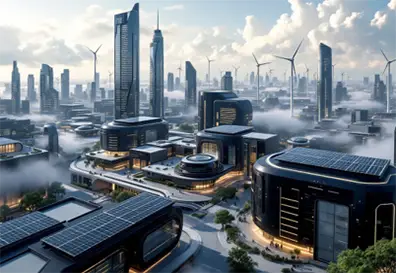Reducing reliance on scarce elements by utilizing alternative semiconductors.

Advanced Materials: Driving Innovation, Sustainability, and EU Competitiveness
Powering Progress: The EU's Critical Raw Material Challenge in Key Sectors
Across mobility, electronics, construction, and energy sectors, the EU's increasing dependence on Critical Raw Materials underscores the urgent need for diversified supply chains, innovative recycling methods, and strategic partnerships to ensure sustainable economic growth and technological advancement.
Advanced materials are paving the way for sustainable solutions. These materials enhance performance, reduce dependencies on critical raw materials (CRMs), and boost EU competitiveness.

Electronics
The EU relies heavily on gallium, germanium, tantalum, and rare earth elements for consumer electronics and digital technologies.

Mobility
E-mobility transition requires lithium, cobalt, nickel, platinum group metals, and rare earth elements for batteries and motors.

Construction
The sector uses aluminium, copper, feldspar, niobium and borates for various applications in building technologies.

Energy
Green transition demands silicon, rare earth elements, graphite, and vanadium for renewable energy technologies.
Powering Electronics Innovation
The electronics sector's reliance on CRMs, including gallium, germanium, tantalum, and cobalt, poses significant challenges. Advanced materials provide innovative alternatives to mitigate these dependencies.
Quantum dots and perovskites for high-definition displays and advanced sensors.
Employing graphene-based photodetectors for high-speed optical communications.
Designing recyclable electronic components to foster a circular economy.
Revolutionizing Mobility with Advanced Materials
The mobility sector heavily relies on CRMs like rare earth elements (neodymium, dysprosium), lithium, cobalt, nickel, and platinum group metals. Advanced materials can offer solutions to reduce these dependencies and improve vehicle performance.

Lightweight Composites
Improves fuel efficiency by reducing vehicle weight.

CRM-Free Magnets
Eliminates rare earth elements in electric motors.

Bio-Based Polymers
Enhances sustainability through renewable resources.

Novel Battery Chemistries
Reduces lithium and cobalt use for enhanced sustainability.
Building a Sustainable Future
The construction sector depends on CRMs like chromium, manganese, vanadium, and rare earths, especially for lighting. Advanced materials are transforming construction practices to reduce CO₂ emissions and enhance infrastructure lifespan.
Bio-based concrete lowers CO₂ emissions through sustainable building practices.
Using smart materials enhances structural durability, ensuring longevity.
Self-healing materials extend infrastructure lifespan by automatically repairing damage.
Advanced insulation technologies provide enhanced energy efficiency for buildings.
Energizing the Future with Innovation
The energy sector relies on CRMs such as rare earths (neodymium, dysprosium), silicon, graphite and cobalt. Innovative materials are crucial for enhancing energy efficiency, reducing CRM dependency, and supporting sustainable solutions.
 Perovskite Solar Cells
Perovskite Solar Cells
Perovskite solar cells and tandem photovoltaics offer high efficiency in energy conversion.
 Advanced Storage
Advanced Storage
Advanced storage solutions reduce lithium dependency through innovative technologies.
 Hydrogen Storage
Hydrogen Storage
Innovative hydrogen storage materials support clean energy initiatives.
 Carbon Capture
Carbon Capture
Carbon capture technologies using porous materials help mitigate climate change.
Europe at the Forefront of Advanced Materials Research
- Europe is leading the charge in advanced materials research.
- This is done through strategic initiatives like the Materials 2030 Manifesto and the Critical Raw Materials Act.
- These efforts align with global sustainability goals and strengthen EU competitiveness.
The European Commission's Communication on Advanced Materials for Industrial Leadership (COM(2024) 98 final) outlines 14 key actions to drive innovation and competitiveness in Europe. One of these actions is to identify the research and innovation needed to reduce dependencies on Critical Raw Materials (CRMs) by developing alternative Advanced Materials.
Reducing Dependencies on Critical Raw Materials through Advanced Materials
Stakeholders from industry, research, and policy are encouraged to contribute their expertise in advanced materials. Collaborative efforts can accelerate innovation and significantly reduce CRM dependencies, solidifying Europe's leadership in advanced materials research.
We encourage stakeholders to participate actively. For furhter details visit the dedicated page.
For questions or assistance, contact us at: JRC-Advanced-Materials-CRM@ec.europa.eu
We look forward to your contributions to this important initiative!
